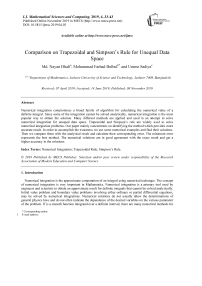Comparison on Trapezoidal and Simpson’s Rule for Unequal Data Space
Автор: Md. Nayan Dhali, Mohammad Farhad Bulbul, Umme Sadiya
Журнал: International Journal of Mathematical Sciences and Computing @ijmsc
Статья в выпуске: 4 vol.5, 2019 года.
Бесплатный доступ
Numerical integration compromises a broad family of algorithm for calculating the numerical value of a definite integral. Since some of the integration cannot be solved analytically, numerical integration is the most popular way to obtain the solution. Many different methods are applied and used in an attempt to solve numerical integration for unequal data space. Trapezoidal and Simpson’s rule are widely used to solve numerical integration problems. Our paper mainly concentrates on identifying the method which provides more accurate result. In order to accomplish the exactness we use some numerical examples and find their solutions. Then we compare them with the analytical result and calculate their corresponding error. The minimum error represents the best method. The numerical solutions are in good agreement with the exact result and get a higher accuracy in the solutions.
Numerical Integration, Trapezoidal Rule, Simpson’s Rule
Короткий адрес: https://sciup.org/15017129
IDR: 15017129 | DOI: 10.5815/ijmsc.2019.04.04
Список литературы Comparison on Trapezoidal and Simpson’s Rule for Unequal Data Space
- Muthumalai R K. Some Formulae for Numerical Differentiation through Divided Difference. International Journal of Mathematical Archive. 2012, 03.
- Khan M M, Hossain M R and Selina parvin. Numerical Integration Schemes for Unequal Data Spacing. American Journal of Applied Mathematics. 2017, 5(2), 48-56.
- Thukral R. Further Acceleration of the Simpson’s Method for Solving Non-linear Equation. Journal of Advances in Mathematics. 2018, 14, 02.
- Jayakumar J. Generalized Simpson-Newton's Method for Solving Nonlinear Equations with Cubic Convergence. IOSR Journal of Mathematics. 2013, 7(5), 58-61.
- Atkinson K E. An Introduction to Numerical Analysis, John Wiley & Sons, New York. 1978.
- Conte S D. Elementary Numerical Analysis. McGraw Hill, New York. 1965.
- Curtis F G, Patrick O. Wheatley. Applied Numerical Analysis. Pearson Education, Inc. 2004.
- Gill P E, Miller G F. An Algorithm For the Integration of Unequally Spaced Data. The Computer Journal. 1972, 15, 80-83.
- Cheney W, David Kincaid. Numerical Mathematics and Computing. Thomson Brooks/Cole. 2008.
- Faires J D, Burden L R. Numerical Analysis, Thomson Learning. 2001.
- Hildebrand F B, Graw-Hill M C. Introduction to Numerical Analysis. 2nd Edition, New York. 1974.
- Eskandari H. Simpson’s Method Solution for Non-linear equation, Scientific Research Publishing Inc. 2017, 8, 929-933.
- Liang X P. A Numerical Integration Method of Dynamic Finite Element Analysis. Scientific Net. Advanced Materials Research, 2011, 199-200, 1257-1261.
- Hou J, Kui Liu and Qian Mu Li. Analysis on Calculating Numerical Integration Methods of Common Social Science Field. Scientific Net, Applied Mechanics and Materials. 2012, 121-126, 4391-4395.
- Filiz A. Numerical Solution of a Non-linear Volterra Integro differential Equation via Runge-Kutta-Verner Method. International Journal of Scientific and Research Publications. 2013, 3 (9), 1-8.
- Kambo N S. Error of the Newton-Cotes and Gauss-Legendre Quadrature Formulas, Mathematics of Computation. 1970, 24, 110.
- Sinha R K and Kumar R. Numerical method for evaluating the integrable function on a finite interval. International Journal of Engineering Science and Technology. 2010, 2(6).
- Sozio G. Numerical Integration. Australian Senior Mathematics Journal. 2009, 23(1).
- Mantzaris N V, Daoutidis P and Srienc F. Numerical solution of multi-variable cell population balance models: I. Finite difference methods. Computers & Chemical Engineering. 2001, 25(11-12), 1411–1440.
- Abia L M, Angulo O, Lopez-Marcos J C and Lopez-Marcos M A. Numerical integration of a hierarchically size- ´ structured population model with contest competition. Journal of Computational and Applied Mathematics. 2014, 258, 116– 134.


